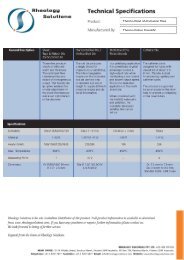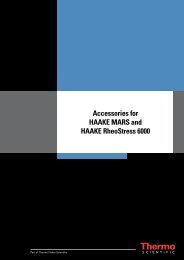Download - Rheology Solutions
Download - Rheology Solutions
Download - Rheology Solutions
Create successful ePaper yourself
Turn your PDF publications into a flip-book with our unique Google optimized e-Paper software.
• application notes & technical articles<br />
Rheological properties of bitumen modified with<br />
polyethylene and polyethylene based blends<br />
Introduction.<br />
construction &<br />
building industries<br />
Nowadays a very large majority of the roads are<br />
constructed using a mixture of bitumen (5 wt. %)<br />
and mineral aggregates. Notwithstanding this low<br />
bitumen content, the performance of the road<br />
pavement is determined by the properties of the<br />
bitumen, as bitumen is the continuous phase and<br />
the only deformable component. On the other<br />
hand, from a technological point of view, the<br />
The rheological properties of<br />
polymers in shear as well as in<br />
extensional flow are essential<br />
for their processing.<br />
continuously increasing traffic load on road<br />
pavements has resulted in tightening of binder<br />
specifications in order to obtain higher mechanical<br />
stability of asphalt roads. However, the limit of<br />
increasing pavement performance with conventional<br />
pure bitumen seems to have been reached.<br />
To achieve this improvement, it is necessary the<br />
addition of natural or synthetic polymers to the<br />
bitumen. The aim of this project is to obtain<br />
modified bitumens, using several synthetic<br />
polymers, like polyolefins or rubbers. The<br />
optimisation of composition and processing<br />
conditions will be carried out by taking into<br />
account the stability and rheological properties of<br />
bitumens for road paving under extreme<br />
conditions, which should be processed with<br />
conventional or slightly modified machinery.<br />
Keywords.<br />
EPDM/PE blends; Polyolefin modified bitumens;<br />
Bitumen rheology; Polymer/bitumen blends<br />
A full copy of this paper is available on request by<br />
quoting RF-190902-ES-01<br />
• application notes & technical articles<br />
Measurement of the Irganox content in<br />
polypropylene polymers during extrusion<br />
Abstract.<br />
Near infrared spectroscopy was used as an in-line<br />
control system for the measurement of polypropylene<br />
filled with different amounts of Irganox<br />
additives. For this purpose transmission probes<br />
were installed in an extruder. The probes can<br />
• application notes & technical articles<br />
New die design for the characterisation of the<br />
extensional and shear properties of polymers<br />
for laboratory and on-line use<br />
biennial 07-08<br />
polymer industries<br />
polymer industries<br />
withstand temperatures up to 300oC and<br />
pressures up to 60 MPa. Transmission spectra of<br />
polypropylene mixed with Irganox with a coefficient<br />
of models were generated with partial least square<br />
regression which resulted in a model which<br />
estimated Irganox with a coefficient of determination<br />
of 0.984 and root square error of prediction of<br />
0.098%. Furthermore the possibilities for<br />
controlling process conditions by measuring<br />
transmission at a specific wavelength were shown.<br />
Unfortunately their complete characterisation in<br />
the laboratory requires the complementary use<br />
of sophisticated techniques which are time<br />
consuming and need great expertise.<br />
Therefore quality control is mainly limited to<br />
the measurement of a melt flow index, a shear<br />
viscosity and eventually a melt strength test to<br />
assess extensional properties. The on-line<br />
monitoring of material parameters would be very<br />
helpful but is today mostly restricted, whenever<br />
performed, to MFI or a capillary shear viscosity<br />
measurement.<br />
Keywords.<br />
polymer, irganox, extrusion, in-/on-line<br />
Reference: W. Becker and N. Eisenreich, J. Near<br />
Infrared Spectroscopy. 13, 147 – 154 (2005).<br />
© NIR Publications. www.impublications.com<br />
The HAAKE X-die has been developed to cover<br />
the need for a quick characterization in shear<br />
and extension, with little or even no operator<br />
intervention. It can be mounted on a traditional<br />
capillary rheometer or directly on-line with a melt<br />
pump feeding it. Data obtained by this die with a<br />
standard LDPE already tested in round robin tests,<br />
are presented and confirm the validity of this new<br />
approach.<br />
A full copy of the laboratory report is available on<br />
request by quoting LR-39<br />
28 www.rheologysolutions.com










